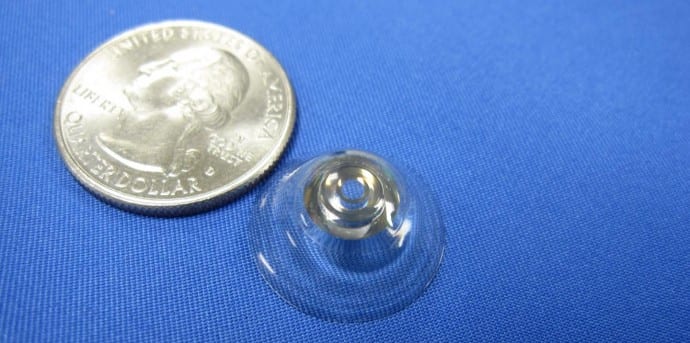Six million dollar man’s bionic eye becomes reality
Once the vision of science fiction is about to soon become an everyday reality, as optics specialist Eric Tremblay revealed a unique contact lens that would provide the user with telescopic vision. Earlier this year, the lens was disclosed at the annual meeting of the American Association for the Advancement of Science (AAAS) in San Jose, California.
Introduced in 2013, the new contact lens is a more advanced model of a prototype, which is 1.55 millimetres thick and features a very thin, reflective telescope that enables the user to zoom in and out in factually a wink. The telescopic contacts are made with stiff lens known as a scleral lens, which are bigger in diameter than the more acquainted soft contacts, but useful for special cases, such as for people with unevenly shaped corneas. Scleral lenses are safe and comfortable for special applications, in spite of their size and stiffness, and are an interesting platform for technologies such as optics, electronics and sensors.
So, how does it all work? According to the research team, which in addition to Tremblay (of the Swiss Ecole Polytechnique Federale de Lausanne) includes developers from the University of California San Diego, Paragon Vision Sciences, Innovega, Pacific Sciences and Engineering and Rockwell Collins, “Small mirrors within bounce light around, expanding the perceived size of objects – magnifying the view, so it’s like looking through low magnification binoculars.”
That’s correct. Telescopic vision.
Other vital improvements include by putting the lens in tiny air channels that are approximately 0.1 mm wide that allows more oxygen penetrability for the oxygen to flow around and beneath the lens. Also, ‘smart’ glasses are built alongside the lens that will reply to the wearer’s winks (but not blinks), letting the wearer to shift almost back and forth between magnified vision and regular vision without any effort; kind of a Clapper for your super vision…’wink on, wink off’.
The project which was originally funded by the US government research agency DARPA for its potential military applications has huge potential for the approximate 285 million people around the world who are visually impaired due to age-related macular degeneration (AMD). AMD is one of the leading causes of blindness among older adults. Even though currently there are glasses for people with AMD, they are likely to look awkward and clumsy, as they can hinder social interaction due to the mounted telescopes. Further, they need continuous positioning of the eyes and leaning of the head to use them, as they are unable to track eye movement. Contact lens with such abilities enables easier reading as well as better recognition of faces and objects. Consider it as the ultimate improvement for bifocals in 230 years.
“We think these lenses hold a lot of promise for low vision and age-related macular degeneration. At this point this is still research, but we are hopeful it will eventually become a real option for people with AMD,” Tremblay said. “It’s very important and hard to strike a balance between function and the social costs of wearing any kind of bulky visual device. There is a strong need for something more integrated and a contact lens is an attractive direction.”
Tremblay also pointed that there are still some twists that needs to be worked upon before the lenses are ready for the general market. However, they could help millions of older adults to see: their family, their friends, and their grandchildren as and when they become available, which is undoubtedly worth a lot more than six million dollars.
Source: Forbes

